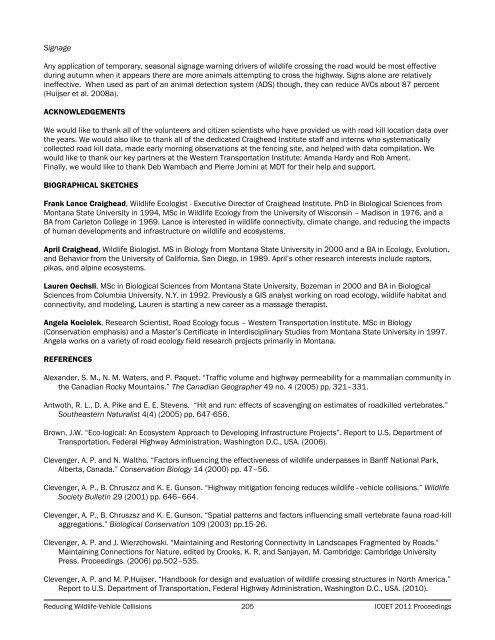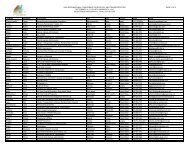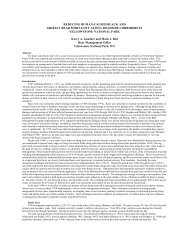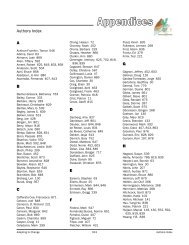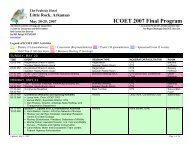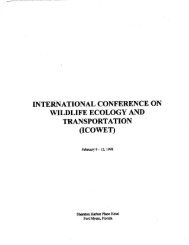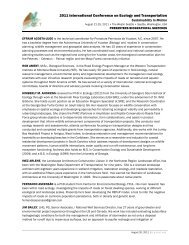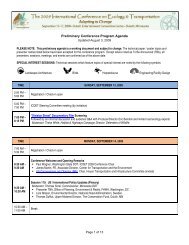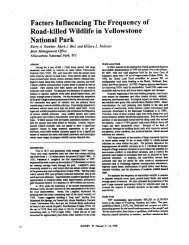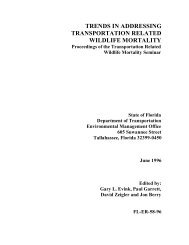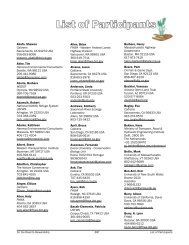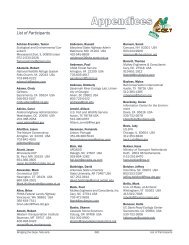e considered in terms of its economic costs, social costs, and environmental costs. As wealth accounting becomesapplied at finer scales, more precise estimates of the true costs of animal-vehicle collisions may include such things as(rough estimates): the loss of a full day of work to the motorist who hit the deer ($200), the loss of efficiency at workdue to injury or stress ($500), the delays in commerce of trucking accidents ($100), the value of the deer meat to ahunter who is unable to harvest the animal ($200), the value to a game processor who could have butchered andwrapped the meat ($150), the loss of future reproduction in the deer population ($400), loss of carbon sequestration,loss of prey to carnivores, decline in carrying capacity of the environment for carnivores and subsequent loss of huntingand viewing, and so on. Although many of these costs may seem trivial, when multiplied by the number of UVCs acrossthe nation it is likely that the true environmental and social costs of current highway designs will add significantly to thedirect financial costs of UVCs and collisions with other animals.Design Recommendations for Bozeman Pass Study AreaThe effectiveness of underpasses and overpasses at reducing AVCs has been estimated at an average of 86 percentwhen used in combination with large-mammal fencing (Huijser et al. 2008b). Our remote camera data indicate thatexisting underpasses, without wildlife fencing, vary greatly in use by wildlife and this may be due to differences in thestructures themselves or the terrain nearby.FencingAdditional wildlife fencing would probably increase the use of existing bridges and culverts if it were placed so thatwildlife were directed to those crossing structures. Photo data from additional remote cameras indicate that a varietyof species currently utilize other culverts. Snow track data indicate that deer cross the highway in winter in areas wherethey could more safely travel through nearby bridge or culvert underpasses.UnderpassesThe construction of new underpasses would not be as cost-effective as adding wildlife fencing to existing structures, butnew structures near the hotspot sites around MP 309.7 and 313 would likely be effective at reducing AVCs. There areno existing structures immediately adjacent to those sites. Underpasses may also be effective if built close to thehotspots near MP 321, 325, 328, and 332 on the Livingston side of Bozeman Pass. Although the existing underpassesnear MP 328 were not observed to be used by wildlife, a better design of culvert, underpass, or elevated span thatprovides more space and visual openness should be much more effective (Clevenger and Huijser 2010).OverpassesAlong with underpasses, overpasses in combination with wildlife fencing are effective at reducing wildlife vehiclecollisions (Huijser et al. 2008b). Overpasses would be much more expensive (a few million dollars) but if properlylocated could reduce AVCs and increase connectivity for many species of wildlife. Data from overpasses in other localessuggest that even if the overpass is not exactly in a traditional travel route for animals they are likely to learn of itslocation and begin to use it. Locating a crossing structure where there is adequate habitat or compatible land useadjacent to the highway is one of the most important considerations (Clevenger and Huijser 2010, Huijser et al.2008b). Probable sites for an overpass were identified near the hotspots at MP 315 or 316 because of steep terrainand the proximity of the Interstate and the railroad. To be most effective an overpass would need to provide passageover both the highway and railroad (and/or frontage roads) and this area would require the least length of overpass.Jump-outsOur data suggested that most animals did not use the jump-outs as a means of exiting the highway. There are only twodocumented photos of a coyote jumping off the jump-out away from the highway. There were no data from tracks orphotos documenting deer use of jump-outs although they visited the tops of the jump-outs many times. The fact thatthere were no deer road kills within the fence associated with these photos indicates that the deer were able tosuccessfully exit the fenced area without getting hit. We concluded that the jump-outs were too high, with difficultlanding areas, for most animals to use easily. Black bears appeared on the edge of the jump-out wall but could haveclimbed up or down the edge of the jump-out. Cougars were photographed passing over the top of the jump-outs.Placing a berm of dirt at the bottom of the jump-outs to provide a more sloped landing and less of a drop shouldimprove the design so that animals may use jump-outs more easily in this area. Amend the fence to ensure that thereare no gaps between the fence and the jump-out wall such that animals can squeeze through either entering or leavingthe fenced area.<strong>ICOET</strong> 2011 Proceedings 204 Session <strong>COM</strong>-1
SignageAny application of temporary, seasonal signage warning drivers of wildlife crossing the road would be most effectiveduring autumn when it appears there are more animals attempting to cross the highway. Signs alone are relativelyineffective. When used as part of an animal detection system (ADS) though, they can reduce AVCs about 87 percent(Huijser et al. 2008a).ACKNOWLEDGEMENTSWe would like to thank all of the volunteers and citizen scientists who have provided us with road kill location data overthe years. We would also like to thank all of the dedicated Craighead Institute staff and interns who systematicallycollected road kill data, made early morning observations at the fencing site, and helped with data compilation. Wewould like to thank our key partners at the Western Transportation Institute: Amanda Hardy and Rob Ament.Finally, we would like to thank Deb Wambach and Pierre Jomini at MDT for their help and support.BIOGRAPHICAL SKETCHESFrank Lance Craighead, Wildlife Ecologist - Executive Director of Craighead Institute. PhD in Biological Sciences fromMontana State University in 1994, MSc in Wildlife Ecology from the University of Wisconsin – Madison in 1976, and aBA from Carleton College in 1969. Lance is interested in wildlife connectivity, climate change, and reducing the impactsof human developments and infrastructure on wildlife and ecosystems.April Craighead, Wildlife Biologist. MS in Biology from Montana State University in 2000 and a BA in Ecology, Evolution,and Behavior from the University of California, San Diego, in 1989. April’s other research interests include raptors,pikas, and alpine ecosystems.Lauren Oechsli, MSc in Biological Sciences from Montana State University, Bozeman in 2000 and BA in BiologicalSciences from Columbia University, N.Y. in 1992. Previously a GIS analyst working on road ecology, wildlife habitat andconnectivity, and modeling, Lauren is starting a new career as a massage therapist.Angela Kociolek, Research Scientist, Road Ecology focus – Western Transportation Institute. MSc in Biology(Conservation emphasis) and a Master’s Certificate in Interdisciplinary Studies from Montana State University in 1997.Angela works on a variety of road ecology field research projects primarily in Montana.REFERENCESAlexander, S. M., N. M. Waters, and P. Paquet. “Traffic volume and highway permeability for a mammalian community inthe Canadian Rocky Mountains.” The Canadian Geographer 49 no. 4 (2005) pp. 321–331.Antwoth, R. L., D. A. Pike and E. E. Stevens. “Hit and run: effects of scavenging on estimates of roadkilled vertebrates.”Southeastern Naturalist 4(4) (2005) pp. 647-656.Brown, J.W. “Eco-logical: An Ecosystem Approach to Developing Infrastructure Projects”. Report to U.S. Department ofTransportation, Federal Highway Administration, Washington D.C., USA. (2006).Clevenger, A. P. and N. Waltho. “Factors influencing the effectiveness of wildlife underpasses in Banff National Park,Alberta, Canada.” Conservation Biology 14 (2000) pp. 47–56.Clevenger, A. P., B. Chruszcz and K. E. Gunson. “Highway mitigation fencing reduces wildlife–vehicle collisions.” WildlifeSociety Bulletin 29 (2001) pp. 646–664.Clevenger, A. P., B. Chruszsz and K. E. Gunson. “Spatial patterns and factors influencing small vertebrate fauna road-killaggregations.” Biological Conservation 109 (2003) pp.15-26.Clevenger, A. P. and J. Wierzchowski. "Maintaining and Restoring Connectivity in Landscapes Fragmented by Roads."Maintaining Connections for Nature, edited by Crooks, K. R, and Sanjayan, M. Cambridge: Cambridge UniversityPress. Proceedings. (2006) pp.502–535.Clevenger, A. P. and M. P.Huijser. “Handbook for design and evaluation of wildlife crossing structures in North America.”Report to U.S. Department of Transportation, Federal Highway Administration, Washington D.C., USA. (2010).Reducing Wildlife-Vehicle Collisions 205 <strong>ICOET</strong> 2011 Proceedings


